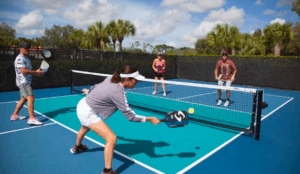
How Pickleball Originated and Evolved Over Time
Pickleball is one of the fastest-growing sports in the world, with millions of players enjoying its fun, social, and competitive aspects. But how did this sport come to be? Why is it called pickleball? What are its origins and how has it changed over time? In this article, we will explore the history of pickleball, from its humble beginnings as a backyard game to its current status as a global phenomenon.
The Birth of Pickleball
- The story of origin of pickleball begins in 1965, on Bainbridge Island, Washington. A group of neighbors, including Washington state representative Joel Pritchard, Bill Bell, and Barney McCallum, were looking for something to do with their families on a summer weekend. They decided to play badminton on an old court on Pritchard’s property, but they could not find a complete set of rackets or a shuttlecock. Instead, they improvised with ping-pong paddles and a perforated plastic ball.
- They soon realized that the ball bounced well on the asphalt surface, and they lowered the net from 60 inches to 36 inches to make the game more challenging. They also made up some rules as they went along, borrowing from badminton, tennis, and table tennis. They named the game pickleball, after Pritchard’s dog Pickles, who loved to chase the ball.
- The game quickly caught on among their friends and family, and they started making more paddles and balls. They also refined the rules and dimensions of the court, which were similar to those of badminton but smaller than those of tennis. They introduced the concept of the non-volley zone (also known as the kitchen), where players could not hit the ball in the air before it bounced. They also adopted the side-out scoring system, where only the serving team could score points.
The Growth of Pickleball

- Pickleball soon spread beyond Bainbridge Island, as more people learned about the game and its benefits. It was easy to learn, fun to play, and suitable for all ages and skill levels. It also required minimal equipment and space, making it accessible and affordable. In 1972, a corporation was formed to protect the creation of the new sport and promote its development.
- In 1975 and 1976, two articles were published in national magazines about pickleball, exposing it to a wider audience. In 1976, the first known pickleball tournament was held in Tukwila, Washington, attracting many college tennis players who were intrigued by the sport. In 1978, a book titled The Other Racquet Sports was published, which included information about pickleball.
- In 1984, the United States Amateur Pickleball Association (USAPA) was organized to perpetuate the growth and advancement of pickleball on a national level. The first rulebook was published in March 1984. The first composite paddle was also made by Arlen Paranto, a Boeing industrial engineer who used fiberglass and honeycomb materials that were used for commercial airplanes.
- By 1990, pickleball was being played in all 50 states. By 2003, there were over 39 places to play pickleball in North America. By 2009, there were over 400 places to play pickleball in North America. By 2013, there were over 2,000 places to play pickleball in North America.
The Evolution of Pickleball
Pickleball has evolved over time in many ways, such as rules, equipment, scoring systems, formats, and organizations. Some of the major changes include:
- In 1999, USAPA introduced a new rating system for players based on skill levels ranging from 1.0 to 5.0.
- In 2001, USAPA adopted rally scoring for tournament play instead of side-out scoring.
- In 2005, USAPA held its first national championship tournament in Buckeye, Arizona.
- In 2009, USAPA became an affiliate member of USA Badminton (USAB), which is recognized by the United States Olympic Committee (USOC) as the national governing body for badminton in the United States.
- In 2010, USAPA launched its official website (www.usapa.org) and established its headquarters in Surprise, Arizona.
- In 2013, USAPA introduced a new four-digit rating system for players based on Universal Tennis Rating (UTR) principles ranging from 1.000 to 6.999.
- In 2014, USAPA changed its name to USA Pickleball Association (USA Pickleball) and adopted a new logo and mission statement.
- In 2015, USA Pickleball held its first U.S. Open Pickleball Championship in Naples, Florida, which became the largest pickleball tournament in the world.
- In 2016, USA Pickleball launched its official magazine (Pickleball Magazine) and established its Hall of Fame to honor the pioneers and contributors of the sport.
- In 2017, USA Pickleball introduced a new four-digit rating system for players based on Dynamic Universal Pickleball Rating (DUPR) principles ranging from 2.000 to 8.000.
- In 2018, USA Pickleball became a member of the International Federation of Pickleball (IFP), which is the international governing body for pickleball.
- In 2019, USA Pickleball held its first National Indoor Championship in Houston, Texas, and its first National Junior Championship in Lake Oswego, Oregon.
- In 2020, USA Pickleball launched its official app (USAPA Mobile) and established its Foundation to support the growth and development of the sport.
- In 2021, USA Pickleball held its first National Collegiate Championship in Surprise, Arizona, and its first National High School Championship in Foley, Alabama.
- In 2022, pickleball was named the official state sport of Washington.
The Future of Pickleball

Pickleball continues to grow and evolve as a sport, with more players, places, events, and innovations emerging every year. Some of the trends and goals for the future of pickleball include:
- Increasing the diversity and inclusion of pickleball players and communities across age, gender, race, ethnicity, ability, and background.
- Expanding the accessibility and availability of pickleball courts near you and equipment in schools, parks, recreation centers, senior centers, and other public facilities.
- Enhancing the quality and consistency of pickleball coaching, officiating, and training programs and resources.
- Developing the competitive and professional aspects of pickleball through tournaments, leagues, tours, teams, and media coverage.
- Promoting the health and wellness benefits of pickleball for physical, mental, and social well-being.
- Advancing the recognition and respect of pickleball as a legitimate sport among other sports organizations and authorities.
- Pursuing the inclusion of pickleball in major multi-sport events such as the Olympic Games, the Paralympic Games, and the World Games.
Conclusion
Pickleball is a sport that has a rich and fascinating history that spans over half a century. From its humble beginnings as a backyard game to its current status as a global phenomenon, pickleball has captured the hearts and minds of millions of people around the world. As pickleball continues to grow and evolve over time, it remains true to its original purpose: to provide a game that the whole family can play together.







